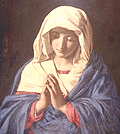The Feast of the Assumption(圣母升天節(jié))
[ 2006-08-20 00:00 ]
|
| August 15th
(Catholic) |
|
The Feast
of the Assumption is an important day in the Catholic religion. It is the
principal feast of the Blessed Virgin, the mother of Jesus Christ. This
feast commemorates two events: the departure of Mary from the soul life
and the assumption of her body into heaven.
In 1950, Pope Pius (庇護(hù),15世紀(jì)以來(lái)的歷代意大利籍天主教教皇的稱(chēng)號(hào)) XⅡdefined that Mary
"after the completion of her earthly life...was assumed body and soul into
the glory of Heaven." Her body wasn't allowed to corrupt nor was it
allowed to remain in a tomb.
 In the early Christian centuries relics (宗教中指圣骨,遺體) of saints
and those who gave their lives for the faith were jealously guarded and
highly prized. Many cities claim the mortal remains of saints, both famous
and little-known. But there are no records of Mary's bodily remains being
venerated (尊敬,崇拜) anywhere. In the early Christian centuries relics (宗教中指圣骨,遺體) of saints
and those who gave their lives for the faith were jealously guarded and
highly prized. Many cities claim the mortal remains of saints, both famous
and little-known. But there are no records of Mary's bodily remains being
venerated (尊敬,崇拜) anywhere.
In the Celtic lands, mid August was harvest time. The festival of
Lughnasa was the harvest celebration in honor of (出于對(duì)某人的敬意) the God of the
harvest Lugh who was responsible for the bounties of the harvest. There
was singing and drinking and dancing and story telling in gratitude for
the harvest and the promise of food to eat during the winter months. In
Christian times it became the festival of Mary at Harvest Time because
Mary reflected the life giving, life nurturing love of God.
As the Feast of the Immaculate Conception (圣靈懷胎) proclaims the grace of
Christ in Mary before he was born, so the Feast of the Assumption points
to the fulfillment of that grace, when Mary was taken, body and soul, into
heaven to share in the glory of her Son's Resurrection (耶穌復(fù)活).
Like the mystery of her Immaculate Conception, the Assumption of Mary
is significant for all humanity, since she anticipates our resurrection
with Christ in glory.
| |